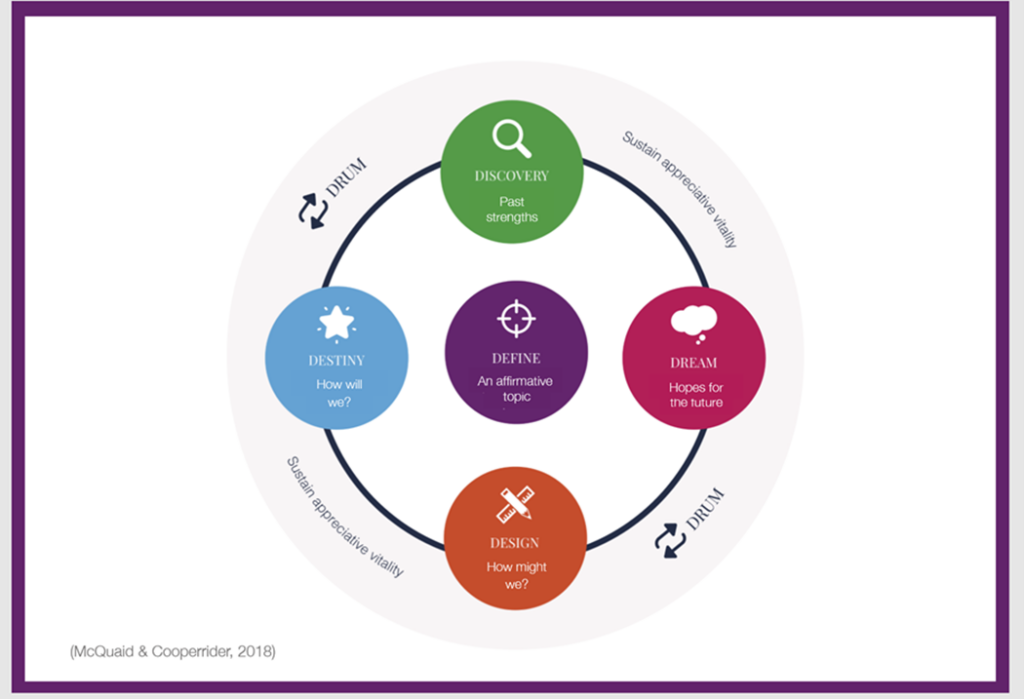Appreciative Inquiry: How it works and how we’ve used it
Through her work on a range of different elements of our Midlands leadership learning offer, Emma Coller from Growth Pod has had great success in facilitating the development of the leadership skills and behaviours needed for positive change. Here she shares her insights on the appreciative inquiry process and how it works:
“Positive change is our ability to move toward what is positive and possible, to look forward with a growth mindset, flourish by leaning into change and be able to positively navigate the natural ups and downs that life and work throws at us.
There are many tools that we can use to help us facilitate this process which moves us positively through change, toward possibilities and away from problems.
One such tool, which we have used widely across our leadership development work in the Midlands, is appreciative inquiry.
Appreciative inquiry can be used in many different contexts, from projects to meetings and as we have been teaching in the Midlands LLL mentoring for leader’s programme, in coaching and mentoring.
Let’s explore how this 6D model works.

The first step sees us define a topic for discovery which is the starting point for moving us from problem thinking to generating possibilities. Our brain is wired to look for problems, so we naturally start from this lens. We might say, we have low morale in our workplace, we would then flip it to a possibility by reframing the problem from low morale to higher morale. We then chose a positive intent statement by framing it, which might look something like, we want teams that are thriving. This becomes the defined statement, our first D.
We then move to discovery. Here we look for what gives life to the system. We search and explore all the positives that relate to our framed statement. This starts the processes with positivity. We often forget to look for what went well but when we intentionally looking, we find it.
Our third D is the dreaming phase. Here we focus on what we want when at its best. We need to give full permission to be creative and innovative here. Dream big. In our example, what would team look, feel, and behave like when they were thriving, how would it impact on colleagues, customers and our business may be a few questions you could explore.
The next D allows us to design the architecture that will move us into making the dream a reality. Using our example, if we want teams that thrive, we then move to questions focused on, how do we create it in reality. We may develop ideas around team building, building psychological safety, providing training on well-being and resilience, inclusion training, coaching or mentoring.
Then we move on to destiny, this D focuses on how we will action the design. This stage helps us to explore what we will do, who will take responsibility and how we will go about it. It’s like the road map.
Finally, we drum. If we want to realize our dream we drum to keep momentum going, drum up motivation, action, implementation, evaluation. If we want to see sustained change, drumming is vital.”
When we began thinking about what events, workshops and masterclasses we wanted to procure for 21/22 we got together and asked ourselves, what went well in 20/21? We thought about what we’d like ideally for the next year, how we could reorganise, fix and resolve issues that had come up in our last journey and what we will do going forward to ensure that we deliver a successful suite of leadership development opportunities.
As our offer is going to be made available soon, we hope that this process as well as gathering data on feedback will have guided us in the right direction and NHS staff in the Midlands benefit from our training, and in turn so do the patients.
Let us know in the comments if you have heard of appreciative inquiry, if your team also uses it or if this is a new term for something you do organically? How have you used it? Do you find it helpful? Is there anything we are missing? We welcome your experiences and knowledge.